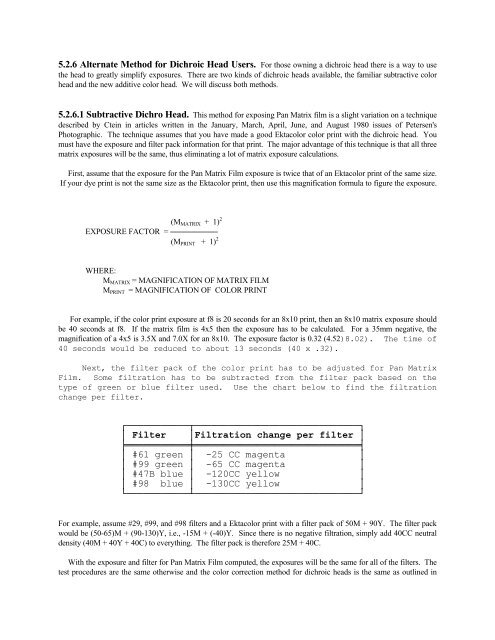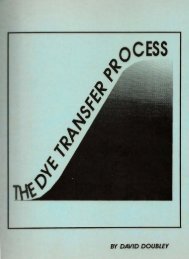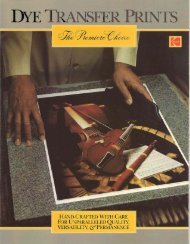Pan Matrix Film Processing - David Doubley
Pan Matrix Film Processing - David Doubley
Pan Matrix Film Processing - David Doubley
You also want an ePaper? Increase the reach of your titles
YUMPU automatically turns print PDFs into web optimized ePapers that Google loves.
5.2.6 Alternate Method for Dichroic Head Users. For those owning a dichroic head there is a way to use<br />
the head to greatly simplify exposures. There are two kinds of dichroic heads available, the familiar subtractive color<br />
head and the new additive color head. We will discuss both methods.<br />
5.2.6.1 Subtractive Dichro Head. This method for exposing <strong>Pan</strong> <strong>Matrix</strong> film is a slight variation on a technique<br />
described by Ctein in articles written in the January, March, April, June, and August 1980 issues of Petersen's<br />
Photographic. The technique assumes that you have made a good Ektacolor color print with the dichroic head. You<br />
must have the exposure and filter pack information for that print. The major advantage of this technique is that all three<br />
matrix exposures will be the same, thus eliminating a lot of matrix exposure calculations.<br />
First, assume that the exposure for the <strong>Pan</strong> <strong>Matrix</strong> <strong>Film</strong> exposure is twice that of an Ektacolor print of the same size.<br />
If your dye print is not the same size as the Ektacolor print, then use this magnification formula to figure the exposure.<br />
(M MATRIX + 1) 2<br />
EXPOSURE FACTOR = ──────────<br />
(M PRINT + 1) 2<br />
WHERE:<br />
M MATRIX = MAGNIFICATION OF MATRIX FILM<br />
M PRINT = MAGNIFICATION OF COLOR PRINT<br />
For example, if the color print exposure at f8 is 20 seconds for an 8x10 print, then an 8x10 matrix exposure should<br />
be 40 seconds at f8. If the matrix film is 4x5 then the exposure has to be calculated. For a 35mm negative, the<br />
magnification of a 4x5 is 3.5X and 7.0X for an 8x10. The exposure factor is 0.32 (4.52)8.02). The time of<br />
40 seconds would be reduced to about 13 seconds (40 x .32).<br />
Next, the filter pack of the color print has to be adjusted for <strong>Pan</strong> <strong>Matrix</strong><br />
<strong>Film</strong>. Some filtration has to be subtracted from the filter pack based on the<br />
type of green or blue filter used. Use the chart below to find the filtration<br />
change per filter.<br />
┌───────────┬─────────────────────────────┐<br />
│ Filter │Filtration change per filter │<br />
╞═══════════╪═════════════════════════════╡<br />
│ #61 green │ -25 CC magenta<br />
│<br />
│ #99 green │ -65 CC magenta<br />
│<br />
│ #47B blue │ -120CC yellow<br />
│<br />
│ #98 blue │ -130CC yellow<br />
│<br />
└───────────┴─────────────────────────────┘<br />
For example, assume #29, #99, and #98 filters and a Ektacolor print with a filter pack of 50M + 90Y. The filter pack<br />
would be (50-65)M + (90-130)Y, i.e., -15M + (-40)Y. Since there is no negative filtration, simply add 40CC neutral<br />
density (40M + 40Y + 40C) to everything. The filter pack is therefore 25M + 40C.<br />
With the exposure and filter for <strong>Pan</strong> <strong>Matrix</strong> <strong>Film</strong> computed, the exposures will be the same for all of the filters. The<br />
test procedures are the same otherwise and the color correction method for dichroic heads is the same as outlined in




